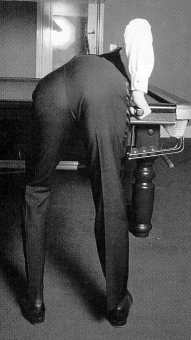During the coming season, Terry Griffiths, who has just
launched the
Terry Griffiths School of Coaching will be writing a series of
'Coaching Articles', which we hope will help you to enjoy and improve your game. Each
article will feature a different aspect of the game, with some tips and advice for you
to work on.
Anyone with a question or a comment can send Terry an e-mail at
[email protected].
Terry Griffiths continues his series of Coaching Articles, concentrating on Getting The
Basics Right. The first article featured Your Grip, now Terry gives
you his advice on ensuring that you have a solid stance at the table:
Technique - Stance
There are two basic types of stance used by players. Nowadays many of the top professionals,
including Steve Davis and
Stephen Hendry use the "modern"
square on stance.
| |

|
| Steve Davis |
|
The traditional stance was the left foot in front of the right, as used by the great
Champions such as Joe Davis.
In both cases, the left knee is bent and is parallel with the line of the shot. The right
leg is straight and braced. Your weight must be slightly forward. The height and physique of
the player will help determine where he puts his left foot, but his right foot should be in
line with the shot so that the cue moves directly over it. (This applies to right-handed
players, with left-handed players the reverse applies).
Most players form their stance naturally and stick with it. However, since the top players
have so much exposure on TV, players tend to copy them. This is not always a good idea!.
Changing your natural stance can lead you into other problem areas. It can change the angle
of your hips, chest and head position. This could lead to you not aligning yourself
correctly.
Don't forget the main function of the stance is to provide you with a firm and solid base,
which allows you to deliver the cue through on a straight line.

|
| Joe Davis |
|
|
There are several obvious faults that can occur with a player's stance:
Having your feet too close together will mean that you are not solidly balanced at the table.
If you have your feet too far apart, you will not have your foot in line with your cue and
you will tend to lean, causing you to be both off balance and not in line with the shot.
If you have one foot directly in front of the other, you will be off balance and will move
on the shot.
Test your stance by standing away from the table, bending forward into your stance, without
the support of the table and see if you are still comfortably balanced.
If you are not happy with your stance, consult a coach before making any adjustments.
Back to the top
Error processing SSI file
Ready for the next article?
|